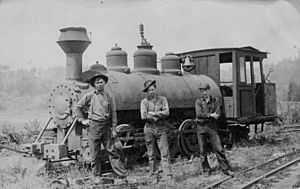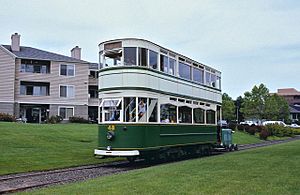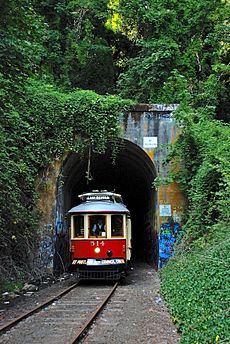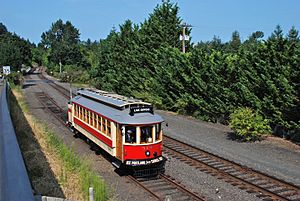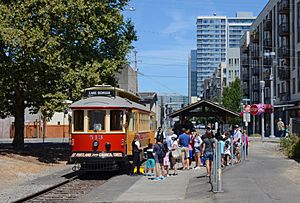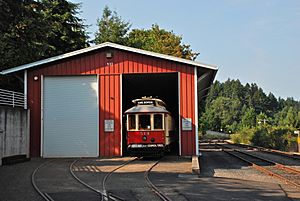Willamette Shore Trolley facts for kids
Quick facts for kids Willamette Shore Trolley |
|
|---|---|
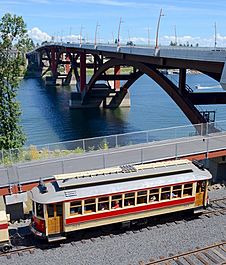
Car 513 passing the new Sellwood Bridge in 2018
|
|
| Overview | |
| Other name(s) | Willamette Shore Railway (1987–90) |
| Status | Operating |
| Locale | Clackamas / Multnomah counties, Oregon, USA, in Portland metropolitan area |
| Termini | Lake Oswego (State St. near A Ave.) Portland (South Waterfront; Moody & Bancroft) |
| Website | http://wst.oregontrolley.com |
| Service | |
| Type | Heritage streetcar, seasonal operation |
| Operator(s) | Oregon Electric Railway Historical Society |
| History | |
| Opened | 1987 |
| Technical | |
| Line length | 5.51 miles (9 km) |
| Track gauge | 1,435 mm (4 ft 8 1⁄2 in) standard gauge |
| Electrification | None; electricity supplied by portable diesel generator |
| Operating speed | 15 mph (24 km/h) |
The Willamette Shore Trolley is a special kind of train line. It's called a heritage railroad or heritage streetcar. This means it uses old or replica trains to show how things used to be. It runs along the west side of the Willamette River. The route goes between Portland and Lake Oswego in Oregon.
A group of local governments bought the land the trolley runs on in 1988. They wanted to save it for possible future train use. The trolley started offering rides as a test in 1987. Regular trips began in 1990. The Oregon Electric Railway Historical Society has been running the trolley since 1995.
The trolley offers fun rides using a historic or replica train. It travels on an old Southern Pacific train line. This line used to be called the Jefferson Street Branch Line. The route is about 5.5 miles (9 km) long. It includes a trip through the 0.25-mile-long (0.4 km) Elk Rock Tunnel.
In Lake Oswego, the trolley starts downtown. It's next to State Street, just south of A Avenue. The Portland starting point has changed over the years. Since 2003, it's been at SW Bancroft Street and Moody Avenue. This is in the new South Waterfront area.
All trolley service stopped in July 2010. This happened because the line's only streetcar broke down. In 2013, they got a new streetcar. It was a Gomaco-built replica of an old trolley. This allowed service to start again on the southern part of the line in August 2014. Service to Portland was brought back on July 21, 2017.
Contents
History of the Train Line
The path the Willamette Shore Trolley uses today was first set up in the mid-1880s. It was built by the Portland and Willamette Valley Railway. Steam trains started carrying passengers on July 4, 1887. This gave Oswego (now Lake Oswego) a direct link to Portland. Before this, people could only get to Oswego by rough roads or river boats.
The Southern Pacific Company later bought the line. They made the tracks wider in 1914. They also added electricity for the trains. This led to the busiest time for passenger travel in 1920. Back then, 64 "Red Electric" interurban trains ran daily.
The line first went around Elk Rock on a long bridge. Elk Rock is a bend in the river north of Elk Rock Island. In December 1921, a tunnel replaced the bridge. The Elk Rock Tunnel is 1,396 feet (426 m) long. It's located in the Riverwood area, between Portland and Lake Oswego. Passenger service stopped on October 5, 1929. However, the line was still used for freight until 1983.
Saving the Line and Test Trolley Rides
In August 1984, Southern Pacific got permission to stop using the line. This made several local governments act. They created a non-profit group to buy the line. Their goal was to save the path for future public transit. This group included Metro, TriMet, and the cities of Portland and Lake Oswego. It also included Multnomah and Clackamas counties. The Oregon Department of Transportation (ODOT) later joined them.
The line's official name was the Jefferson Street Branch. This was because it had a station called Jefferson Street. It also continued into downtown Portland on that street.
In January 1987, the City of Portland leased the 6.2-mile line from Southern Pacific. They also had an option to buy it. In autumn 1987, a heritage streetcar service started. This was a test to see if people liked it. It also helped show why the line should be saved.
This test trolley service began on September 12, 1987. The Oregon Electric Railway Historical Society (OERHS) ran it. They used a double-deck trolley from Blackpool, England. OERHS called the service the Willamette Shore Railway. It ran only on weekends and holidays until the end of the year.
The line does not have overhead wires for power. So, a diesel engine on a cart provided electricity. This cart was towed behind or pushed in front of the trolley. The Portland starting point was near Moody Avenue. The Lake Oswego starting point was about half a mile north of downtown.
The group of governments bought the line from Southern Pacific in October 1988. They paid $1.9 million. This included the cost of a planned extension in Lake Oswego. Metro saw it as a possible route for future public transit.
Regular Service and Extensions
Regular, seasonal vintage streetcar service began on July 6, 1990. It was now called the Willamette Shore Trolley. A private company, Gales Creek Enterprises, ran it for the first five seasons. They had a contract with the City of Lake Oswego.
They used a streetcar built in 1913 from San Antonio, Texas. A diesel-powered generator trailer again provided electricity. The ends of the line stayed the same as the 1987 test service. It was near the Marquam Bridge in Portland and near State Street in Lake Oswego.
In 1993, new track was laid in Lake Oswego. This allowed the trolley service to extend south. It now ended just south of A Avenue, closer to the city center. The ticket office moved to a small building at the new Lake Oswego end. Since then, round-trip rides have started from the south end. The contract with Gales Creek Enterprises ended in 1994.
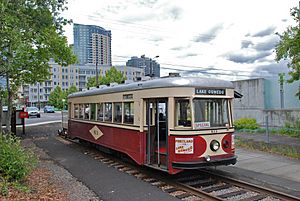
In 1995, the Oregon Electric Railway Historical Society again became the operator. They had a longer contract with Lake Oswego. Trolley rides started again in August 1995. They first used an open-sided streetcar from Sydney, Australia, as a temporary car. The main car was a 1928-built Blackpool tram 48. This was the same double-deck trolley OERHS used in 1987. The double-decker started service on November 24, 1995.
In December 1996, another streetcar joined it. This was a 1932 Brill "Master Unit" streetcar. It had worked its whole life in Portland. These cars were nicknamed "Broadway cars."
In April 1997, the line was extended north to the RiverPlace area. This made the line about 7 miles (11 km) long. Because of big construction in the new South Waterfront district, this new section was last used in September 2003. Service then stopped at a new terminal south of Bancroft Street.
The Blackpool double-decker stopped regular use in late 2003. It moved to OERHS's museum in May 2006. After that, the 1932 Portland Brill streetcar, No. 813, was the only one on the line.
The trolley runs seasonally, not all year. The main season is usually from May to October. There are also a few special runs in December for the holidays. The line is very popular on the Fourth of July. People can watch the Oaks Amusement Park fireworks from the river. It's also popular in mid-December for the Christmas Ships Parade.
From 2009 to Today
For most of 2009, all service stopped. This was to fix the line's four trestle bridges. The longest is Riverwood Trestle, which is 686 feet (209 m) long and about 75 feet (23 m) high.
Service started again during the 2009 holiday season. The 2010 season began on May 1. But the line's only streetcar broke down on July 16, 2010. This caused service to stop for a long time. It stayed stopped in 2011 and 2012. Repairing the car was too expensive. No other streetcar was available.
OERHS decided that fixing the 1932 streetcar, Portland Brill car 813, would cost too much. So, they looked for a replacement. Car 813 moved to the Oregon Electric Railway Museum in June 2012.
In early 2013, they leased a new streetcar. The group hoped to start service again in summer 2013. In October, they said it would be summer 2014 instead. On August 16, 2014, service finally restarted. The new car is a copy of a 1904 Portland "Council Crest"-type Brill streetcar. It was built in 1991 by the Gomaco Trolley Company. It was used on the Portland Vintage Trolley service.
This car is number 514. It moved to Lake Oswego on March 26, 2013. A year later, another replica streetcar, car 513, moved to Lake Oswego. This happened on September 8, 2014. It was stored for future use.
The line reopened for rides on August 16, 2014, using car 514. There was a lot of construction for the new Sellwood Bridge. This meant the trolley could not run all the way to Portland for a while. When it reopened in 2014, it only ran between Lake Oswego and Riverwood. A year later, on August 8, 2015, service extended north to Powers Marine Park. This is just south of the Sellwood Bridge. This made the line in use about 3 miles (5 km) long. The 2016 season began on May 28.
The 2017 season began on May 27. The northern end of the service was still at Powers Marine Park. But the track near the Sellwood Bridge was fixed. Test runs were done. On July 21, 2017, service was extended back to its Portland end at Bancroft Street. This is one block from the South Waterfront end of the Portland Streetcar's NS Line.
Car 513 was fixed and started running on the WST in 2018, on May 26. Before this, it had not carried passengers on the Portland Streetcar line for over 12 years.
Battery Power for Trolleys
In early 2019, workers started changing car 514. They began removing old DC motor parts. The plan is to change the streetcar to AC motors and battery power. This new system is a team effort between WST volunteers and EVDrive Inc. EVDrive is a company in Hillsboro, Oregon.
If this works, the trolley won't need a diesel generator anymore. AC motors will also allow "regenerative braking." This means the brakes can put power back into the battery. This will make the battery last longer. The AC motors were planned for late summer 2019. The battery pack was still being made. The money for car 514's change is all set. They are also raising money to change car 513 to this new system later.
The Carbarn
Since 1998, the Willamette Shore Trolley has had a special building. It's called a carbarn. This building has two tracks. It's near the Lake Oswego starting point. Here, the trolley cars are stored and fixed.
Before 1998, any trolleys used on the line had to be kept outside. They had fences to protect them from damage or theft. But they were not well protected from the weather. The carbarn is 3,000-square-foot (280 m2) in size. It was finished and opened in September 1998.
Future Transit Ideas
There's an idea to turn this line into an extension of the Portland Streetcar. It would run through Johns Landing and into Lake Oswego. Metro, Portland, Lake Oswego, and TriMet have studied this idea.
Work on an environmental study started in spring 2009. It looked at the streetcar idea. It also looked at "enhanced bus" service, or bus rapid transit (BRT). The streetcar idea faced challenges from people living near the tracks. But Metro preferred the streetcar. This was partly because BRT might need one car lane to be given to buses. The current road, Hwy. 43, is too narrow to widen. Planning for this idea stopped in early 2012. This was because the estimated costs kept going up.


